Did you know that the average cost-per-acquisition (CAC) for B2B SaaS businesses is $942? [1]
Seems like an awful lot, right? And that’s only when we talk about organic marketing channels. When we talk about non-organic, the CAC jumps to $1907[1].
But hey, don’t worry – we’ve got the key ingredient you need to lower your CAC – building a SaaS customer journey map.
And we’ll teach you how to do it right!
Additionally, if you’re looking to optimize your SaaS strategy from every angle, working with a SaaS consulting agency can help you streamline your processes and reduce costs effectively.
Before we get started, enjoy the following video by our CEO and Founder Alexej Pikovsky. Here, he shares the five major differences between the B2B and B2C SaaS customer journey.
What Are Customer Journey Touchpoints for SaaS Businesses?
But before we dive deeper into building your own SaaS customer journey map, let’s start by understanding your business’s customer touchpoints. Understanding your customer touchpoints is just one part of the equation. Implementing a strong B2B SaaS SEO strategy can significantly enhance your visibility and engagement at each touchpoint. Discover how our specialized B2B SaaS SEO services can help your business grow.
SaaS businesses have customer journey touchpoints that take place when customers use your product in various stages of their customer lifecycle. These touchpoints are important for creating relationships between the SaaS product and its users. How you handle these touchpoints is what affects customer happiness, keeping them as clients, and finally getting their loyalty.
But what are the most common customer journey touchpoints for SaaS businesses? Let’s see:
- Your SaaS website is usually the initial encounter potential customers have with your product. They usually go there to learn details about the product, its cost, client comments, and other relevant information.
- Giving people a chance to try the product before they commit is an extremely important touchpoint in the decision-making process. Free trials and demos are the way to go.
- Once a customer signs up, the B2B SaaS onboarding process is key to making sure they understand how to use and implement your SaaS. The onboarding can include tutorial videos, step-by-step guides, or even personalized training.
- Interactions with customer support can be through various channels such as live chat, email, support tickets, or phone calls. How well you talk to and help clients greatly influences their satisfaction.
- Regular email updates about new features, updates, maintenance schedules or newsletters offer a continuous form of interaction with the customer.
- Asking for feedback, either through surveys or direct approaches, can enhance the product and customer service and show customers that their thoughts are important.
- For enterprise clients or higher-tier customers, an account manager should have regular check-ins to guarantee that you fulfill customer’s requirements and fulfill them while dealing with problems quickly.
- Another critical touchpoint is interaction during renewal or upgrade processes. In such cases, there may also be an opportunity for upselling extra features or products.
- Engagement in forums, webinars, conferences, or social media where customers can interact with one another and the company can strengthen the feeling of community and connection.
- Your approach to handling cancellations or attempts to win back customers can create an impression that influences the chance of future re-engagement.
SaaS Touchpoints Examples
To help you understand customer touchpoints, let’s go through the example of Zendesk, a customer service solution.
When visitors come to Zendesk’s website, an interactive Chatbot guides them through different solutions based on their needs, provides an instant answer to their burning questions, and directs them to appropriate resources or human support.

Besides utilizing the Chatbot, Zendesk also uses a popup that triggers after users have already spent some time on their website. And what’s the popup all about? It prompts users to try, completely for free, an interactive product demo. This is a great strategy to engage customers when they visit a website because it perfectly shows the capabilities of Zendesk’s solution.
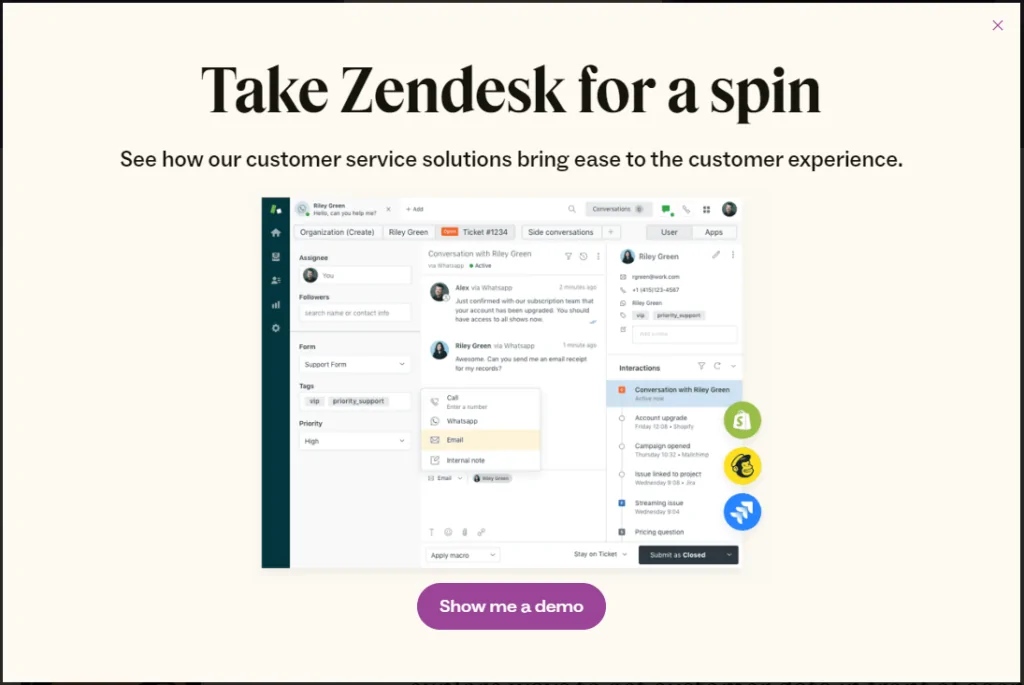
When it comes to an example of free trials, Dropbox offers its potential customers an unparalleled experience. The goal you should aim for in this customer touchpoint is to remove as much friction as possible.
Dropbox achieves that by offering a 30-day free trial for its Business version, which includes a guided setup and suggestions on organizing files for teams. This immediately resolves pain points their target audience has, and showcases the immediate productivity boost that Dropbox offers.
If you’re wondering how to utilize your account managers to positively influence your ARR, you can learn a lot from Microsoft. They assign dedicated account managers to enterprise clients, and provide regular reviews and proactive recommendations to optimize the use of Microsoft 365 services.
Different Types of SaaS Customer Journey Maps
Depending on your goal, you can create one or more SaaS customer journey maps. The reason for having additional types of SaaS customer journey maps is to make each map unique and suitable for diverse business goals. Each kind of journey map concentrates on a distinct aspect of the customer experience or a specific phase in their life cycle with your organization.
Now, let’s look at these various kinds of SaaS customer journey maps to assist you in selecting the one that is most appropriate for your business:
Current State Map
These maps help to show how customers experience your SaaS product now. You make them with the purpose of recording what is happening in the current customer journey without guessing about any improvements or alterations. This kind of map can be good for finding problems and places where you need to improve things immediately.
Why Choose the Current State Map
- A Current State Map provides a realistic view of the customer journey as it currently exists, without assumptions or alterations. You’ll be able to identify areas where customers have difficulties and prioritize accordingly.
- You’ll understand customer behavior better and align your marketing and sales efforts according to your learnings.
How to Use It:
- Use the map to conduct a comprehensive gap analysis by comparing the current customer journey against the desired journey or best practices.
- Identify over-utilized or underutilized resources across the customer journey.
- Establish key performance indicators (KPIs) at various customer journey stages identified in the map.
For example, tools like Hotjar can record user sessions and see where they drop off. If many users don’t complete the sign-up process, you can determine which step to give up and provide better information or simplify the process. Maybe they don’t quite understand the difference between your free trial and a free plan, and it’s worth explaining it better on the signup page.
After implementing the changes, compare previous session recordings with the current ones and see whether the performance improved.
Future State Map
In contrast to current state maps, future state journey maps show the expected or perfect way a company wants its customers’ journey to be. When planning strategies and designing services, you can use these types of maps as a compass to guide development and change within your organization.
Why Choose Future State Map:
- The Future State Map serves as a roadmap for change. It outlines the necessary steps and changes required to move from the current state to the desired future state, helping to manage transitions and implement new strategies smoothly.
- This mapping ensures that future planning and development are centered around creating value for the customer, leading to stronger relationships and increased loyalty.
How to Use It:
- Use the map as a blueprint to develop specific projects or initiatives needed to achieve the future state. This includes identifying new technologies to adopt, processes to redesign, features to develop, or customer touchpoints to enhance.
For example, maybe you want to tailor your SaaS product to attract a certain type of buyer persona. You can work on developing the features this use case would appreciate the most and tailoring the product to better meet their needs.
Day-in-the-Life Customer Journey Maps
These maps give a wider picture of what customers do every day, not only their engagements with your SaaS product. They assist in comprehending where the product stands within the client’s complete workflow, which is very important to spot fresh product opportunities or SaaS growth marketing strategies.
Why Choose Day-in-the-Life Map:
- This type of map captures the holistic view of customer’s daily activities and understand the context in which they use your SaaS product.
- A Day-in-the-Life Map reveals gaps in the current product offering or service delivery that may not be apparent through other types of journey mapping.
How to Use It:
- Use insights from the map to innovate or improve products. Understanding the customer’s day can highlight opportunities where your product could better address specific needs or pain points, leading to more relevant enhancements or innovations.
- Tailor your marketing and sales approaches based on a detailed understanding of when and how customers are most likely to use your product.
For example, if project managers use your product, you can determine whether they frequently check for updates early in the morning, require quick syncing with multiple teams throughout the day, and review project statuses in the evening.
You can implement changes such as developing features that allow users to schedule messages for optimal times ensuring communications are sent during team members’ peak active hours.
Service Blueprint
This is more than a typical customer journey map because it shows the customer’s front-end interaction and back-end processes, service touchpoints, and actions of various departments.
What does this mean?
Service blueprints can help us make sure that all teams in the organization are working together and the whole process of delivering services supports a good experience for customers.
Why Choose Service Blueprint:
- By detailing all the steps and processes involved in service delivery, a Service Blueprint helps you identify inefficiencies, redundancies, or gaps that you can improve.
- The blueprint helps you align various departments (e.g., customer service, IT, operations) by clearly showing how each team’s actions impact the overall customer experience.
How to Use It:
- Use the blueprint to analyze and optimize each step and process involved in service delivery. Look for ways to reduce unnecessary steps, automate processes, and enhance efficiency.
- The Service Blueprint can serve as a training tool for new employees to understand their role in the service delivery process.
For example, if the blueprint shows long wait times due to certain back-end approvals, look for ways to streamline these processes. If you identify that customers experience significant delays during the support ticket escalation process, you should re-evaluate the necessity of each approval step.
Besides, you could also determine the severity of issues automatically based on predefined criteria and automatically flag for fast-track escalation, bypassing the normal approval queue.
Onboarding
The maps, which are focused on the new customer onboarding process, serve to confirm that customers can use the SaaS product well. Good onboarding maps lessen early churn while boosting satisfaction and retaining more customers.
Why Choose Onboarding Map:
- An Onboarding Map focuses on ensuring that new users understand and effectively use your product, which is important for reducing churn.
- You can tailor onboarding experiences to different customer segments, addressing their specific needs, concerns, and usage patterns, which can lead to higher engagement and satisfaction.
How to Use It:
- Map out all the touchpoints in the onboarding process, including initial setup, training sessions, and follow-up support. Understanding these touchpoints helps in creating a seamless flow and ensures no crucial steps are overlooked.
- Define metrics for evaluating the success of the onboarding process (such as user activation rates, time to first value, customer satisfaction scores) and use these metrics to assess and refine the onboarding experience.
For example, a new customer from a large enterprise might receive a more in-depth, guided onboarding with a dedicated account manager. At the same time, a startup might go through a more streamlined, self-serve onboarding process.
Additionally, if users typically struggle with a particular setup step, integrating an automated chatbot to offer help at that stage could prevent frustration and improve user experience.
Opportunity Maps
Apply these SaaS customer journey maps to recognize chances for enhancing the client experience or product innovation. How can you make them? Use data gathered in current state maps to choose areas for investment and development.
Why Choose Opportunity Maps:
- These maps encourage a proactive approach to innovation by highlighting areas ripe for development, whether through new features, services, or improved processes.
- Opportunity Maps ensure that you align strategic decisions with actual customer needs and behaviors, investing resources in areas that will offer the highest return.
How to Use It:
- Start by mapping out the complete customer journey, including all touchpoints and interactions. The current state customer journey will help you with this.
- Leverage data from various sources such as customer feedback, analytics, sales data, and market research to identify patterns and trends that suggest opportunity areas.
- Start with pilot projects to test the feasibility and impact of proposed changes on a small scale before rolling them out widely. This approach minimizes risk and allows for adjustments based on initial results.
For example, you’ve used the Opportunity Map to discover that users frequently encounter difficulties integrating your software with other tools. By identifying this as a key opportunity area, you could develop new or improved integration capabilities or even create a marketplace for third-party integrations.
Persona-Based Journey Maps
You adjust these maps to match with customer personas that show the usual users of your SaaS product. Persona-based maps help understand the different needs and behaviors of various user segments, making it possible to create more personalized B2B SaaS marketing funnels and product development strategies.
Why Choose Persona-Based Journey Maps:
- You’ll gain a deep understanding of specific customer segments, exploring their unique perspectives, needs, and pain points throughout the customer journey.
How to Use It:
- For each persona, map out the customer journey, identifying all touchpoints, channels, and interactions they engage with. Highlight the emotional journey as well, noting how each persona feels at different stages.
- Develop targeted marketing campaigns, product features, and customer support strategies based on the insights gained from each persona-based journey map.
- Create detailed landing pages that are optimized for search engines and aligned with persona-based pain points, with product features these personas will love most.
For example, for a tech-savvy persona, an automated, feature-rich onboarding experience might be ideal. You would emphasize automated onboarding in your marketing efforts toward this persona.
In contrast, a less tech-savvy persona might benefit from a high-touch onboarding process that includes human interaction and step-by-step guidance. Make sure to emphasize this in your marketing communications with them.
Micro-Journey
Micro-journey customer maps focus on very specific parts of the customer experience, such as signing up for a free trial or upgrading to a premium plan. Micro-journey maps will be useful if you want to dive deeper into particular customer journey stages and optimize specific touchpoints for conversions.
Why Use Micro-Journey:
- Micro-Journeys allow you to concentrate on specific touchpoints or transitions that drive conversions.
- Micro-journeys enable a high degree of personalization. You can tailor experiences to meet the exact needs and preferences of different customer segments at specific points in their journey.
How to Use It:
- Begin by analyzing the broader customer journey to identify key moments that significantly influence customer decisions, satisfaction, or loyalty. These could be moments like signing up, upgrading a service, or reaching out for support.
- Use data analytics to understand how customers are currently navigating these micro-journeys. Identify pain points, bottlenecks, or opportunities for enhancement. Optimize the flow, content, and interactions to better meet customer needs.
- Implement changes in small, testable increments. Use A/B testing or multivariate testing to compare outcomes and refine the approach based on real customer feedback and performance metrics.
For example, Zapier identified that the micro-journey of creating a new “Zap” (an automated workflow between apps) was crucial for user retention and satisfaction. Yet, it presented challenges for new users unfamiliar with workflow automation concepts.
They’ve mapped out each step a new user takes to create a Zap, from the initial selection of apps to the final confirmation of the workflow.
After that, Zapier provided pre-configured Zap templates as starting points for common tasks, reducing the complexity for new users.
They’ve determined that this was a successful endeavor with A/B testing to compare the new guided setup process against the original method. Metrics focused on were completion rates, time to create a Zap, user satisfaction scores, and subsequent user engagement with the platform.
SaaS Customer Journey Stages
To correctly map your customer journey, you need to understand the stages customers go through. Each stage represents a different phase in the customer’s interaction with your SaaS product, from initial awareness to long-term loyalty and advocacy. Understanding these SaaS customer journey stages will help you manage and optimize customer experience effectively.
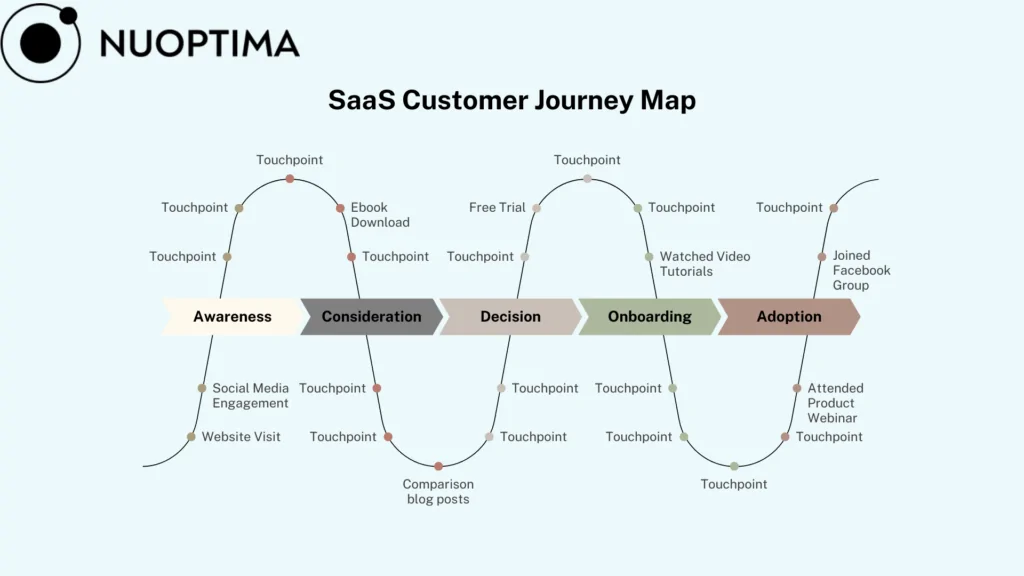
SaaS Customer Journey Stage: Awareness
The Awareness stage is the initial phase of the SaaS customer journey. It sets the stage for how a potential customer knows about and relates to your product. In this phase, potential customers become familiar with your SaaS product for the first time as they see it could be a solution to their problems or needs.
But how?
- Content Marketing
Bond through educational content, including blogs, eBooks, whitepapers, infographics, and videos that tackle the usual problems and difficulties your buyer personas face. The goal is to interact with users by offering value while establishing your SaaS brand as a thought leader.
- SEO
It is important to optimize content marketing efforts for search engines. This ensures that your SaaS product appears in search results when users are looking for solutions related to their issues.
- Social Media
Utilize LinkedIn, Twitter, Facebook, and Instagram to post content, interact with users, and enhance brand recognition. Social media assists in reaching a wider group of people and driving them towards your company’s site.
- Paid Advertising
Using pay-per-click (PPC) campaigns, display ads and social media ads to get attention from a specific group. Paid advertising is very good for quickly making people see your content and bringing them into your sales funnel.
Your main goal in this phase of the SaaS customer journey is to gain attention and make people aware of the problems they may have. Then, you introduce your SaaS product as a possible solution.
P.S. Product-led content does wonders when it comes to this!
Metrics to Track at the Awareness Stage:
- Analyze traffic coming to your website. Use Google Search Console to track branded vs non-branded keywords to determine whether your awareness campaigns have impact and how much.
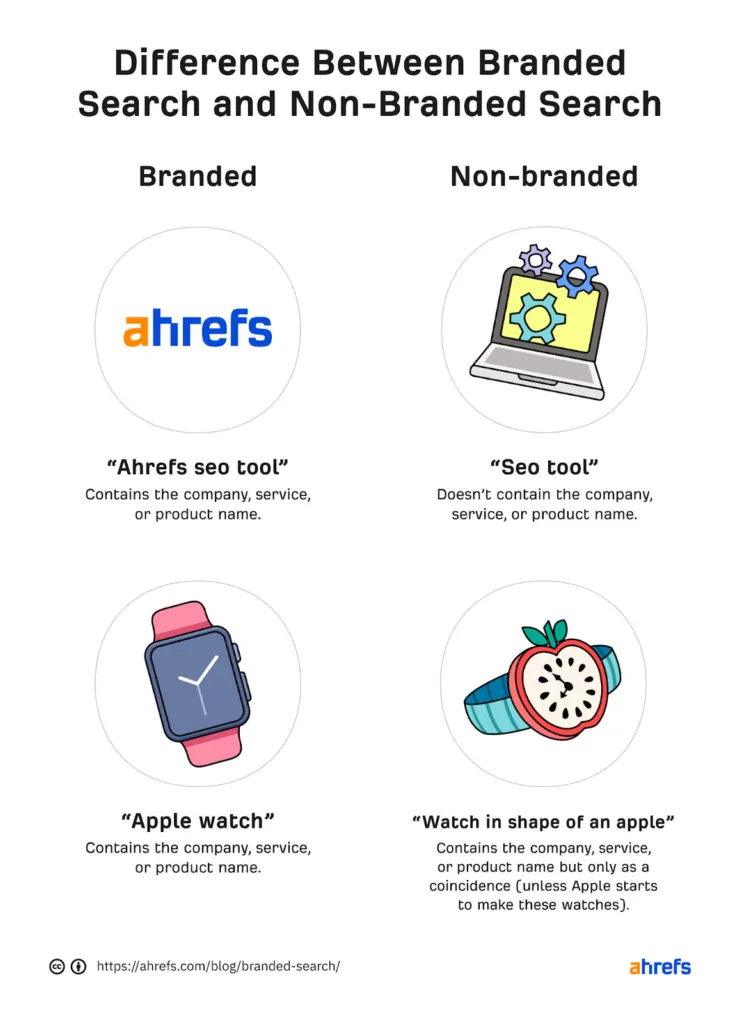
Contribute to: https://ahrefs.com/blog/branded-search/ [4]
- Analyze where your traffic is coming from (organic search, paid ads, social media, referrals, etc.) to determine which channels are most effective at driving awareness.
- Track the number of followers and engagement rates (likes, shares, comments) on your social media platforms.
- Monitor your rankings for targeted keywords to assess your visibility in search engines, which is critical for organic awareness. You can use tools like Semrush and Ahrefs to get daily updates on how you stand for important keywords.
- Measure how many times your ads are displayed and the number of unique users who see your ads.
- The ratio of users who click on your ads compared to the total number of users who view the ads. Higher CTRs suggest that your ad content is relevant and engaging to the audience.
- If you run Digital PR campaigns, track how often your brand is mentioned in the media and shared across different platforms. This can be a strong indicator of brand awareness. There are different tools you can use for tracking brand mentions, including Semrush.
SaaS Customer Journey Stage: Consideration
Great job; potential customers are now aware of your product, and they’ve started evaluating it. What can you do to make sure they convert? The Consideration stage of the customer journey map serves as a tool to engage with customers more deeply, provide detailed product information and position your SaaS business as the optimal solution for their needs.
Case studies, customer testimonials, success stories, whitepapers, ebooks, and comparison blog posts are perfect tools for achieving this. One of the biggest challenges in the Consideration stage is effectively differentiating your product from competitors. It’s crucial to highlight unique features or superior service that make your product stand out.
For example, Zapier implements comparison blog posts and publishes them on its website. While this may seem counterproductive, it is a great strategy for converting people in the consideration stage who’re still unsure whether to choose you over competitors.

Metrics to Track at the Consideration Stage
In the consideration stage, the focus shifts from general awareness to deeper engagement and preliminary decision-making. To measure success, you should:
- Track how deeply leads are engaging with your content and resources. Metrics might include webinar attendance, downloads of whitepapers or case studies, and interaction with interactive tools (like cost calculators or product demos).
- Track micro-conversions that occur during the Consideration stage. These might include signing up for a newsletter, creating an account, using a product configurator, or requesting a free trial. These actions signal interest in deeper engagement.
- Measure how actively users utilize trials. Metrics can include the frequency of logins, features tested, and usage duration. Active trial use often predicts a higher likelihood of conversion.
Once again, tools like heatmaps and session recordings can help understand how users interact with your website and where they spend most of their time, which can indicate interest levels and areas of concern.
SaaS Customer Journey Stage: Decision
It’s time for your customers to cut through the chase and decide. But how can you make sure they choose your SaaS solution?
The primary objective during the Decision stage is to make the decision-making process as easy and clear as possible for the customer. This includes clarifying any doubts, providing robust support, and presenting compelling reasons to choose your product. You can achieve these through various means, including:
- Offering personalized demonstrations or detailed consultations tailored to the specific needs and scenarios of the prospect can help them visualize how the product fits into their workflow and solves their unique problems.
Productboard provides a great example of how to automate product demos and keep them personalized. They strongly focus on the pain points of their target audience and communicate that throughout the demo.
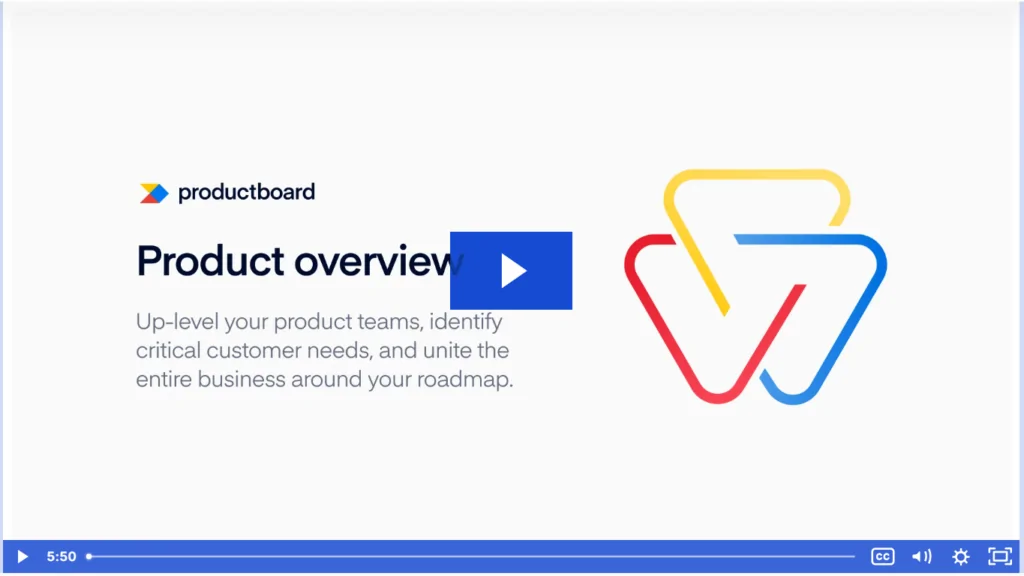
- Clear, transparent, and flexible pricing information that matches the product’s value can help secure the decision.
- Ensuring that the sales team is well-equipped to handle inquiries, provide necessary information quickly, and personalize their communications to the needs of each prospect. Sales support might include providing detailed ROI analyses, compliance information, or data security documentation.
- Since 92% of customers read at least one online review [2], it’s important to include them throughout your website as they can significantly impact your conversion rates.
How to Measure Success at the Decision Stage?
- Track conversions from different sources and channels to identify the most effective driving sales.
- Measure the success of specific marketing campaigns by analyzing how many leads generated from each campaign convert into PAYING customers.
- Calculate the cost of acquiring a new customer by dividing all marketing and sales costs by the number of new customers acquired over the same period.
SaaS Customer Journey Stage: Onboarding
You’ve got yourself a new customer; now what?
The Onboarding customer journey stage is essential for ensuring that new customers understand how to use the product effectively and start seeing value from their investment as soon as possible.
Effective onboarding can significantly influence customer satisfaction, product adoption, and long-term retention.
What should you do during the onboarding stage?
- Send a series of welcome emails.
- Provide training materials for clients and their employees.
- Host webinars, provide user guides, answer FAQs, and send your new customer video tutorials.
- Help customers configure the product to fit their specific workflows and business requirements. This might include assistance with setting up integrations, importing data, or customizing settings.
How to Measure Success at the Onboarding Stage?
55% of customers stop using a product or service they don’t understand. This is living proof of the importance of the onboarding stage in your SaaS customer journey. [3]
If you don’t want your customers to belong to those 55%, measure these:
- The activation metric tracks the percentage of new users who reach a predefined “activation point” or success milestone within a certain period after signing up. This point could be anything from completing a profile setup to executing their first key task or feature within the product.
- Measure how long it takes for a customer to achieve their first significant outcome with your product. A shorter TTFV generally indicates a more effective onboarding process.
- Shortly after the onboarding process, ask customers how likely they are to recommend the product. Use NLP surveys to do it.
- High churn during or immediately after onboarding can signal issues with how new users perceive your product’s value.
SaaS Customer Journey Stage: Adoption
After your customers have successfully onboarded, you’ll want to keep them entertained and hooked on your SaaS product. The Adoption stage follows successful onboarding and focuses on customers fully utilizing the software’s features and integrating it into their workflows. The goal is to make the software an essential part of their business processes, ensuring they recognize its full value.
- Track how new users engage with the software and identify drop-off points or underused features. Provide targeted support and resources to encourage broader usage. You can do this with specialized tools like Hotjar that record user sessions.
- Offer ongoing training sessions, webinars, tutorials, and tips to educate users about the software’s less obvious features or advanced functionalities. This can help deepen their understanding and skill in using the platform.
- Foster a sense of community among users by inviting them to user groups, forums, or networking events. At these events, users can share tips, best practices, and success stories with other users, enhancing their use of the product and building loyalty.
How to Track Success at the Adoption Stage?
- Develop an engagement scoring system based on activities that indicate healthy product usage, such as sharing the product with others, frequent usage, and regular feature use. Higher scores correlate with higher adoption.
- Monitor the number and type of customer support tickets. A decrease in basic “how-to” queries and an increase in more advanced questions may indicate a maturing user base.
- Monitor how many customers upgrade to higher tiers or purchase additional services, which can indicate that they are finding value in the product and require more functionality.
For example, appointment scheduling software can track the number of appointments to determine the success of the adoption stage.
SaaS Customer Journey Stage: Retention
It’s the right moment to think long-term and work on retaining your customers.
The Retention stage of the B2B SaaS customer journey focuses on keeping customers satisfied, engaged, and committed to the subscription model over the long term. And there are some key things to keep in mind if you want to increase CLV (customer lifetime value) for your SaaS business, and these are:
- Exceptional, proactive customer support. This includes offering multiple channels for support (e.g., live chat, email, phone) and ensuring that customer service is responsive, helpful, and efficient.
- Update the product with new features, bug fixes, and enhancements based on customer feedback and technological advancements.
For example, the Nusii team regularly share insightful information about the product and updates it with new features users asked for. This undoubtedly helps them retain more customers and reduce churn.

- Implement programs designed to keep customers engaged, such as user conferences, webinars, workshops, and newsletters.
- Develop loyalty programs that reward long-term customers. These can include discounts, upgraded service features, or other perks that recognize and incentivize continued business.
- Use B2B SaaS analytics to personalize interactions and product offerings to match customer preferences and usage patterns. Personalization can increase the relevance and value of the product to individual customers.
How to Measure Success at the Retention Stage?
- The most direct measure of retention success is the churn rate, which is the percentage of customers who cancel their subscriptions within a given time period. A low churn rate indicates effective retention.
- Calculate your churn rate: Churn Rate = (Number of Customers at the Beginning of the Period – Number of Customers at the End of the Period) / Number of Customers at the Beginning of the Period.
- Measure NRR (Net Revenue Retention). It tracks the percentage of recurring revenue retained from existing customers over a given time period, including upsells, cross-sells, downgrades, and churn.
- Track the average time it takes to resolve customer issues. Faster resolution times can lead to higher customer satisfaction and retention.
SaaS Customer Journey Stage: Expansion
But what if we tell you that the customer journey doesn’t stop at the retention stage? You can expand your business even more in the Expansion stage of the customer journey. You have two goals here:
- Strengthen the customer’s engagement and reliance on your product by seamlessly integrating more of your services into their business processes.
ClickUp is, once again, a perfect example for making their users utilize more and more features the product offers. They keep an open communication with users and introduce them, little by little, with features that will make their daily business operations easier.

- Grow the revenue generated from existing customers by introducing them to more features, services, or higher product tiers that can provide additional value.
To achieve these goals, you should:
- Have regular interactions with customer success managers who can provide insights into how to utilize the product better and discuss potential expansions that could benefit the customer.
- Use data-driven insights to make personalized recommendations for upgrades or additional products that fit customers’ unique usage patterns and business needs.
- Analyze how customers are using the current product and identify potential needs that aren’t fully met or could be better served with additional features or services.
How to Measure Success at the Expansion Stage?
- Calculate the additional revenue generated from existing customers through upsells, cross-sells, and add-ons.
- Monitor the adoption rates of new or premium features by existing customers.
- Measure changes in the Customer Lifetime Value before and after expansion efforts.
- Collect and analyze customer feedback specifically related to new features or upgraded plans to assess their impact and acceptance among your user base.
SaaS Customer Journey Stage: Advocacy
It’s time to turn your customers into raving fans of your SaaS product, and the Advocacy stage is the perfect moment to do it. What should you do?
Utilize satisfied customers to influence potential customers through their networks, reducing marketing costs and increasing the effectiveness of acquisition efforts.
But wait, how do you do that?
- Identify highly satisfied customers and empower them to share their positive experiences. This can be through formal programs where they can serve as case studies, provide testimonials, or participate in user community events.
- Implement referral programs that incentivize customers to refer new users, often rewarding both the referrer and the new customer. These programs should be easy to use and provide meaningful rewards that align with customer values.
- Build and maintain active user communities (online forums, user groups, social media groups) where customers can share experiences, offer advice, and provide peer-to-peer support. This strengthens the user community and enhances customer loyalty. (E.g. Semrush has Facebook Group where active members share tips and success stories).
Semrush’s competitor, SE Ranking, adopted a similar approach. They also moderate Facebook Group that offers exclusive membership to their users. Users can communicate with each other, but also suggest features and resolve any doubts they may have.
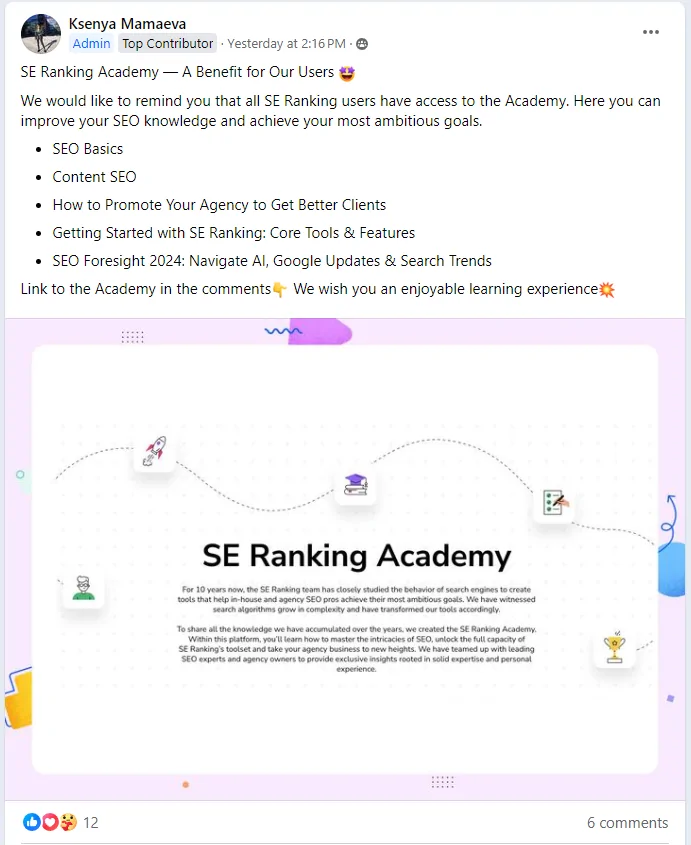
SE Ranking’s employees are also in the group, making sure that no member leaves dissatisfied. They also offer an SaaS affiliate marketing program, which surely helps with turning the average user into a brand advocate.
How to Measure Success at the Advocacy Stage?
- Track the percentage of customers who participate in your referral programs.
- Track how many customers are willing to be featured in case studies or success stories.
- Measure participation in user groups, forums, or community events.
For example, Dropbox, known for its cloud storage solutions, has effectively leveraged customer advocacy by implementing a referral program that rewards both the referrer and the referee with additional storage space.
You can also create a “Customer Spotlight” to boost user activity at the Advocacy stage.
How to Build a B2B SaaS Customer Journey Map? Step-By-Step Guide
It’s time to roll up your sleeves, take notes, and dive straight into action with our step-by-step guide to building a B2B SaaS customer journey map:
Step 1: Define Your Goals
When defining your goals for customer journey mapping, it’s important to talk to your colleagues before choosing the type and align it with broader business objectives. To achieve that, you need to talk to sales, marketing, and customer service departments that will provide you with the necessary support.
Together, you should know if you aim to improve customer satisfaction, reduce churn, enhance user onboarding, or identify upsell opportunities. Clear goals will guide the focus of your mapping efforts.
Using SMART goals to define objectives for customer journey mapping is the best method to make sure the goals are specific, measurable, achievable, relevant, and time-bound.
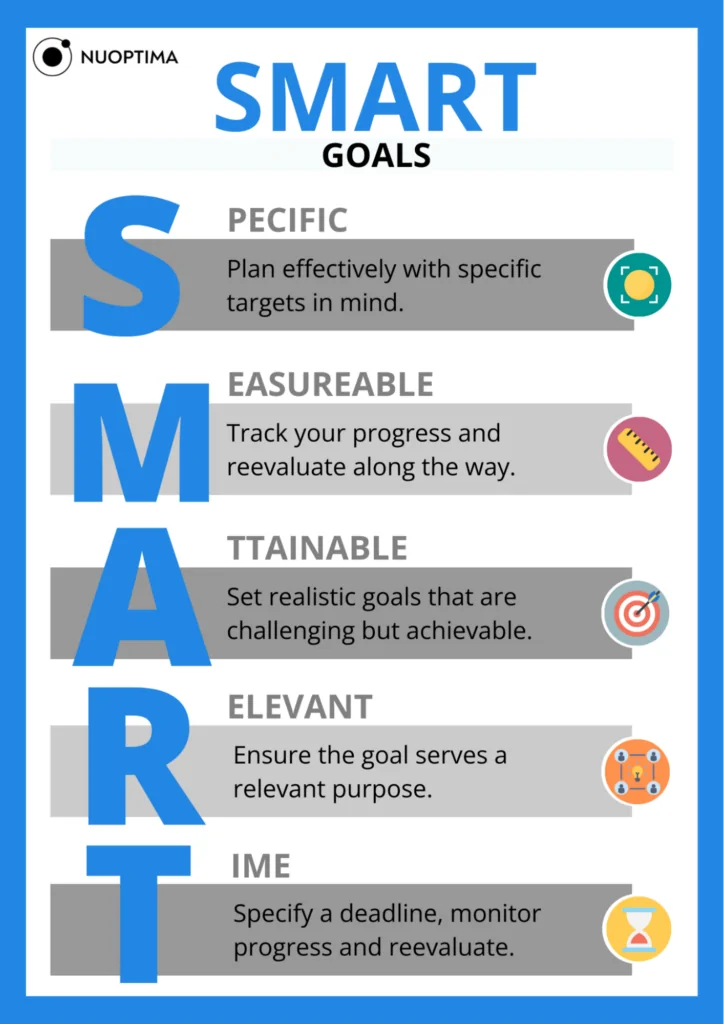
Let’s imagine that your SaaS company wants to improve its onboarding process. You can set a SMART goal like:
“Reduce customer time-to-first-value from 30 days to 20 days within 6 months by implementing guided interactive tutorials and personalized onboarding emails.”
This goal is specific (focuses on time-to-first-value), measurable (reduction from 30 days to 20 days), achievable (through specific onboarding improvements), relevant (improves customer satisfaction and product adoption), and time-bound (set to be achieved within 6 months).
Step 2: Create Buyer Personas
The next step of building a B2B SaaS customer map is to create buyer personas and you can do that by gathering data through customer interviews, surveys, sales feedback and market research. You must understand your customers’ demographics, business roles, goals, challenges, and buying behaviors.
As many SaaS businesses do, you probably have multiple buyer personas, and it’s important to create one for different segments of your target market. Each buyer persona should include job roles, industry specifics, decision-making processes, and unique challenges.
Use your buyer personas to help you tailor the B2B SaaS customer journey map, which will address their problems and put your SaaS brand at the top of their minds.
Questions to Ask Customers
A customer interview is your best friend when creating buyer personas. It’s best to find a successful customer who constantly uses your product for each use case, but you can also start small.
- Can you tell me about your current role and responsibilities?
- What is the size of the company you work for, and in which industry?
- How long have you been in this role or industry?
- What is your educational background?
- What are the main goals you are trying to achieve in your role?
- How do you define success in your job?
- What are the biggest goals for your company this year?
- What are the biggest challenges you face in your role?
- Are there any tools or technologies that you feel are missing that could help you overcome these challenges?
- How do these challenges impact your daily work?
- Can you walk me through how you evaluate and select new tools or software?
- Who else is involved in the decision-making process for purchasing new software?
- What are the key factors you consider when making a purchasing decision?
- How do you currently use our product?
- What features of our product are most valuable to you?
- Are there any features that you feel are lacking or could be improved?
If customers can’t find the time to have a one-on-one interview, you can use tools like SurveyMonkey to create and distribute your survey.
Questions to Ask the Customer Support Team
Since customer support teams are one of the best-informed ones, you can ask them the following questions to create buyer personas:
- What are the most common issues or challenges that customers report?
- Who are the typical users contacting support?
- What are their job roles and industries?
- Are they decision-makers or end-users?
- Which features do customers seem to value the most?
- Do they prefer phone calls, emails, live chat, or another method?
- Does this preference vary by persona (e.g., IT vs. marketing professionals)?
- Which aspects of the product do customers seem to struggle with the most?
- What additional features or improvements do customers often request?
Step 3: Identify Customer Journey Touchpoints
We’ve already mentioned the most common customer journey touchpoints for B2B SaaS businesses, and you should list all the interactions between your customers and the product. These interactions can be direct (product usage, support calls, sales meetings) or indirect (social media engagement, advertising).
As part of your customer journey mapping, you need to list and describe each of these touchpoints in depth.
For each touchpoint, ask yourself these questions:
- What is the goal of this touchpoint from both the customer’s and the company’s perspective?
- What actions does the customer take at this touchpoint?
- What does your company do to engage the customer at this point?
- What might the customer be feeling during this interaction?
- What is the desired outcome of this interaction for both the customer and the company?
But what now?
- To gather data you can use, utilize tools like SurveyMonkey, Typeform, or in-app feedback widgets to gather direct feedback about various touchpoints.
- CRMs like Salesforce or HubSpot can track customer interactions across different touchpoints, providing a holistic view of customer engagements and histories.
- Utilize tools like Tableau or Microsoft Power BI to visualize touchpoints and customer pathways, making it easier to analyze flow and effectiveness at each stage.
Once you identify touchpoints, you should highlight how each touchpoint feeds into the next, affects the customer’s decisions and emotions, and impacts their overall journey and experience with your product.
Step 4: Map Customer Journey Stages
You already know the customer journey stages but need to map them now. How?
For each stage, describe customers’ actions, decisions, and information needs. This helps you understand the path customers follow and where they might encounter obstacles.
For example, a project management SaaS product can map their customer journey stages like this:
| Stage | Customer Actions | Decisions | Information Needs |
| Awareness | Discovering the software through blogs, ads, and referrals. | Deciding to learn more by visiting the website. | General product information, benefits, and customer testimonials. |
| Consideration | Engaging with demos, downloading eBooks, attending webinars. | Evaluating if the software suits their project management needs. | Detailed feature explanations, pricing, comparison with competitors. |
| Decision | Consulting with the team, contacting sales for a final demo. | Making the final purchase decision. | Final pricing details, integration capabilities, customer support services. |
| Onboarding | Setting up an account, integrating with existing tools. | Determining setup preferences and configurations. | Access to training materials, onboarding support, troubleshooting help. |
| Adoption | Regular usage of the software, exploring advanced features | Deciding to integrate deeper into daily operations. | Tips on maximizing productivity, feature-specific guides, best practices. |
| Retention | Renewing subscriptions, engaging with update communications. | Deciding whether to renew based on value assessment. | Update logs, ongoing support options, benefits of continued use. |
| Expansion | Upgrading to a higher plan, adding more user licenses. | Expanding usage due to positive ROI and business growth. | Information on additional features, scalability options, expanded licensing details. |
| Advocacy | Recommending the software to peers, participating in case studies. | Actively promoting the product based on satisfaction. | Details on referral programs, opportunities for testimonials, community engagement. |
Step 5: Gather and Analyze the Data
Use analytics tools, CRM data, customer feedback, and interaction logs to collect information about how customers move through each journey stage. Analyze the data to understand trends, pain points, and moments of delight or frustration. Look for patterns that indicate where improvements are needed.
Tools you can use:
- Tableau
A powerful tool for creating interactive and shareable dashboards that can visualize complex data sets and uncover hidden insights in customer journey data.
- Freshdesk
Customer support tool that aggregates data from various communication channels and provides analytics on ticket trends, agent performance, and customer satisfaction.
- Usabilla
Focuses on collecting real-time user feedback through targeted surveys and in-context feedback forms on websites and apps.
- Heap
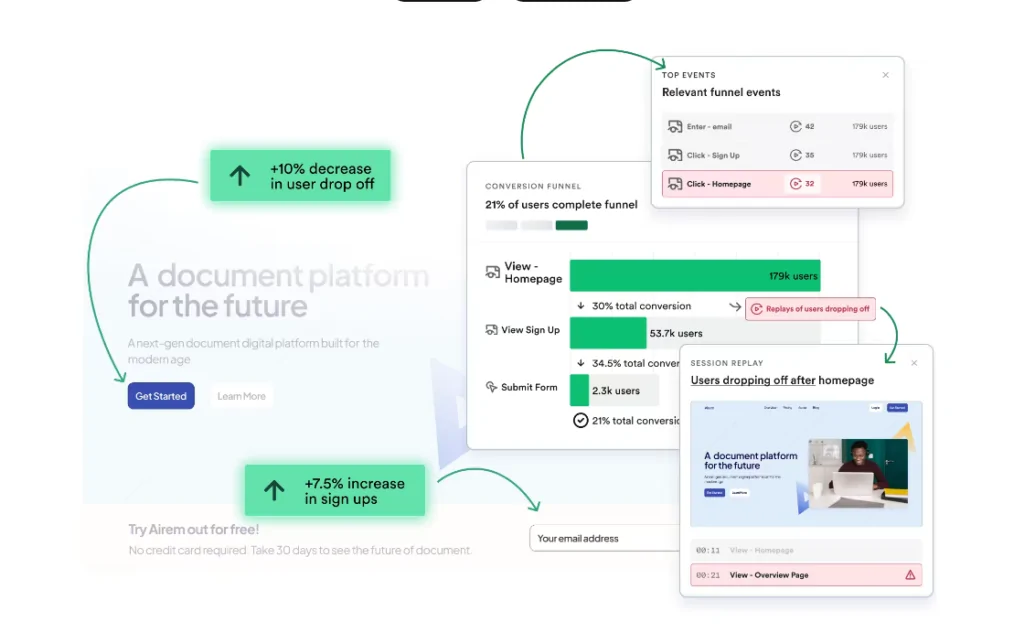
Automatically captures all user interactions on your web or mobile platforms without requiring you to define events upfront, which can be powerful for retroactive analysis.
Step 6: Highlight Milestones
Determine key milestones in the customer journey that are critical to customer success and satisfaction. These might include completing the onboarding process, achieving first success with the product, or renewing a subscription.
Next, evaluate how these milestones affect customer loyalty and lifetime value. Understanding these can help focus efforts on the most impactful aspects of the customer experience.
Key Milestones to Highlight
- Mark the completion of the initial onboarding process, which is critical as it sets the tone for the customer’s ability to use and understand the product effectively.
- Define what ‘first success’ looks like for your customers. This might be the completion of a first project, a notable increase in efficiency, or achieving a particular outcome using your product.
- When a customer refers your product to someone else or gives a positive review.
Now you need to track those milestones and analytics and CRM tools are great for that. Tools like Salesforce, HubSpot, or Zoho CRM can be particularly useful for this purpose, as they allow you to create and monitor custom events and milestones associated with each customer.
After reaching a milestone, send out targeted surveys using tools like SurveyMonkey or Typeform to gather customer experience feedback. Questions should focus on their satisfaction with the product up to that point and their likelihood of continuing use.
If you notice a significant number of customers are failing to reach a key milestone, investigate potential reasons and barriers. Your best bet is to ask them for an interview with your customer success team and incentivize them to do so.
Step 7: Visualize the SaaS Customer Journey
Decide how you will visually represent the journey map. Common formats include flowcharts, storyboards, or diagrams. You can use tools like Lucidchart, Miro, or even PowerPoint. Keep in mind to:
- Construct the map with clear customer journey stages, touchpoints, personas, emotions, and data insights. Ensure it’s easy to understand and accessible to all stakeholders.
- Share the initial draft with stakeholders for feedback. Use their insights to refine and update the map.
For example, Miro is one of the best tools to visualize your customer journey and they have tons of templates you can use and amaze everyone who sets their eyes on it.
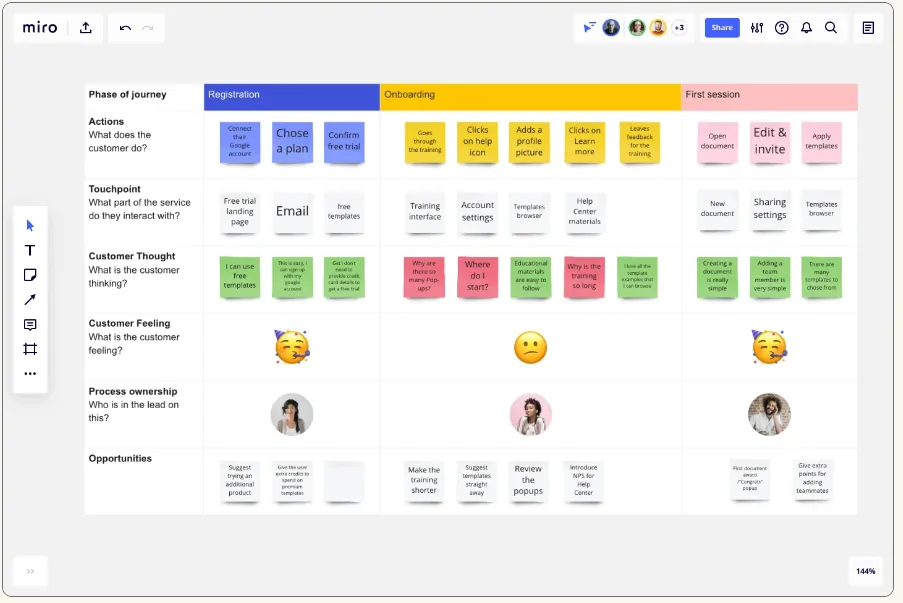
SaaS Customer Journey Map Examples
Wondering what different customer journeys look like in real life? We’ve gathered SaaS customer journey map examples from some of the best businesses in the game.
Let’s check them out:
SaaS Customer Journey Map Example – Slack
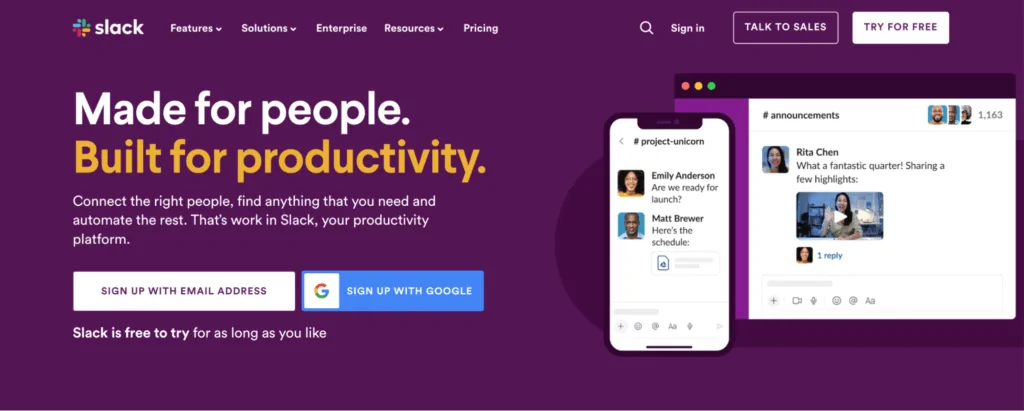
You’ve surely heard about Slack. Maybe even you and your colleagues use it to communicate with each other daily. But have you ever wondered how their customer journey map looks?
Awareness
Prospective users become aware of Slack through various channels, including online advertising, social media, word-of-mouth, content marketing (blogs, webinars, case studies), and partnerships.
Slack’s website offers detailed product information and customer testimonials. It also maintains open communication channels via email and provides website visitors with engaging content.
Consideration
Potential customers start considering Slack as a solution by visiting their website, reading user reviews, watching demo videos, and comparing features and pricing with other communication tools.
Trial and Evaluation
Slack offers a free version with limited features, which is a critical customer journey touchpoint. This allows teams to try the platform without financial commitment.
During the trial, users receive automated emails providing tips on leveraging Slack’s features effectively, along with access to customer support if they encounter issues or have questions.
Purchase and Onboarding
Slack encourages conversion through upgrade prompts in the app and emails that highlight the benefits of paid plans. Once a company subscribes, Slack provides comprehensive onboarding resources, such as guided tutorials, best practices for setting up workspaces, and integration options for various tools.
When they want to access some of the premium features, such as older messages, Slack conveniently encourages users directly from the app to upgrade if they’re going to use it.

Even better, they offer a free trial without any risk so users can see the benefits of Premium plans firsthand.
Adoption
Slack helps teams integrate the tool deeply into their daily workflows by promoting features like channels, direct messaging, integrations, and Slack apps. They also use regular communications to introduce new features and provide tips on improving team collaboration.
Here is an example of how Slack facilitates the Adoption stage for its users with in-app prompts that help them organize their workflow better:
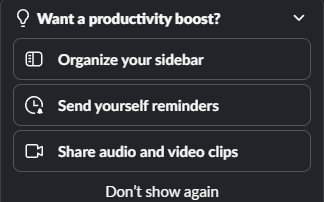
Retention
Ongoing support is crucial. Slack offers robust help documentation, a responsive customer service team, and community forums where users can exchange tips and advice.
Advocacy
Slack encourages satisfied customers to refer the platform to others and engages customers to share the success stories they use to promote their products to a broader audience.
Expansion
As organizations grow, Slack offers scalable solutions and additional features that larger enterprises find valuable, such as extensive integrations. To attract those users, Slack provides extensive documentation that guides them from A-Z, based on their own goals.
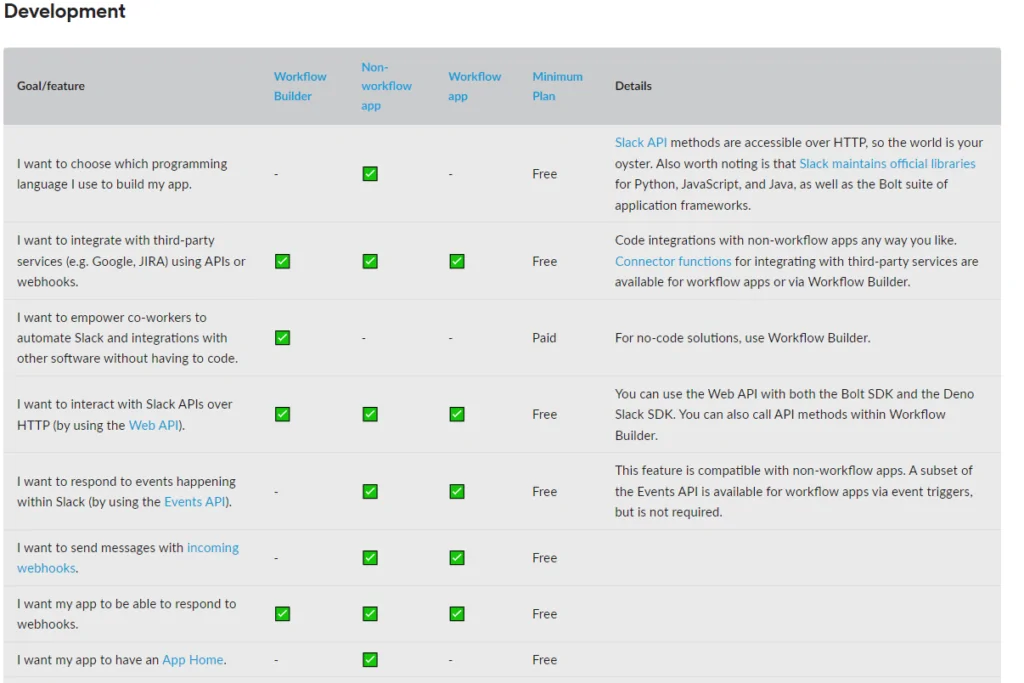
SaaS Customer Journey Map Example – HubSpot
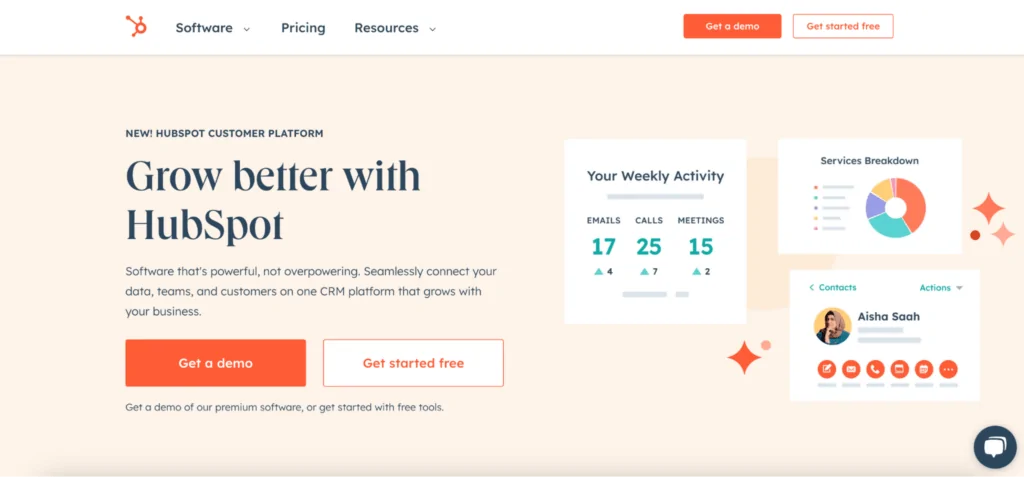
Hubspot targets small and medium-sized businesses and provides comprehensive solutions for SaaS inbound marketing, sales, and customer service. They live and breathe what they preach and their SaaS customer journey map perfectly reflects that. Let’s see their SaaS customer journey map example and learn:
Awareness
HubSpot excels in creating valuable content to attract customers. This includes blogs, ebooks, templates, and educational videos that address common business challenges in marketing, sales, and service, forming the top of their inbound marketing funnel.
Consideration
HubSpot offers various free tools (like website graders, email signature generators, etc.) that prospective customers can use, providing value and introducing the brand’s utility. By leveraging B2B SaaS SEO and active engagement, HubSpot draws potential customers to its resources and tools.
Decision
HubSpot provides a powerful free version of its CRM software, which is a major decision factor for many businesses. This allows potential customers to experience the software’s value firsthand with minimal risk.
Conversion
For new customers, HubSpot offers tailored onboarding experiences, often depending on the tier of service purchased. This includes dedicated customer support and training sessions to ensure successful implementation.
Adoption
HubSpot Academy offers courses and certifications that educate customers on using HubSpot’s tools effectively and on broader inbound marketing strategies.
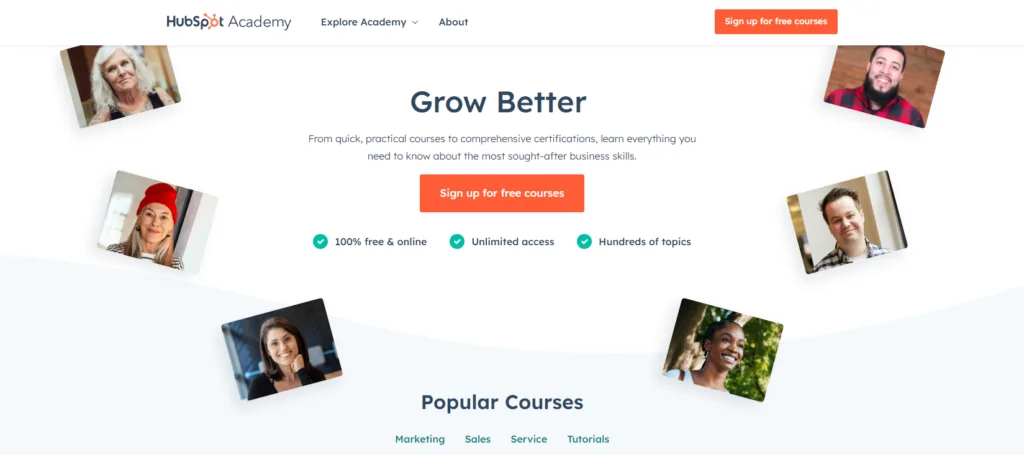
Retention
HubSpot provides extensive customer support through multiple channels, including live chat, email, and phone, ensuring users receive help whenever needed. Plus, they continuously improve and update the platform to keep it competitive and responsive to user needs, which helps retain customers.
Advocacy
Hubspot publishes customer success stories and case studies that showcase how businesses have grown with HubSpot, which promotes advocacy and illustrates tangible SaaS marketing ROI.
Expansion
They utilize cross-selling by offering customers additional services like advanced modules for marketing automation, additional sales tools, or newer service products as part of their customer journey. Plus, they prompt customers to upgrade to higher tiers with more features as their business needs grow.
Conclusion
Don’t allow information to overwhelm or discourage you. Building a SaaS customer journey map is extremely important if you want to gain an edge over your competitors.
While setting the foundation might seem difficult, once you do, you’ll have a clearer understanding of your customers and your processes.
We understand that leveraging these insights to attract high-quality leads requires expertise and time you may not have. This is where Nuoptima’s B2B SaaS SEO services come into play. Why should you even consider us?
- We deeply understand the SaaS customer journey and the exact strategies you need to make each stage a success.
- Our SaaS clients achieve tangible results, such as Quolum that had a 3x traffic jump in 4 months of our services.
- And you get a free blog post when you book a complimentary call because we’re 100% in achieving your goals.
Have some other questions about the SaaS customer journey map? We’ve got you covered with the most frequently asked ones:
FAQ
The customer journey in SaaS is a complete sequence of experiences that a customer goes through when interacting with a SaaS product, from initial awareness and consideration through to purchase, usage, and long-term loyalty.
The 7 steps to map a customer journey are:
- Start by defining your goals
- Create buyer personas
- Identify customer touchpoints
- Map customer stages
- Gather and analyze the data
- Highlight milestones
- Visualize the customer journey
There are 5 main stages of the customer journey, and those are:
- Awareness
- Consideration
- Purchase
- Retention
- Advocacy
The SaaS customer journey consists of 8 different stages: awareness, consideration, acquisition, onboarding, adoption, retention, expansion, and advocacy.